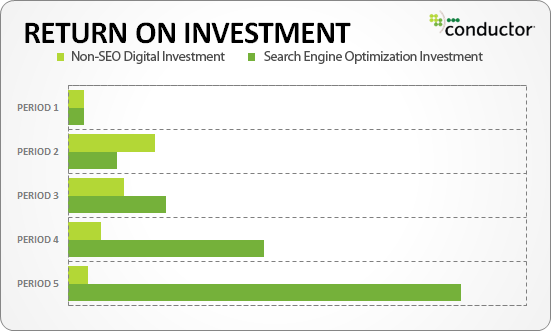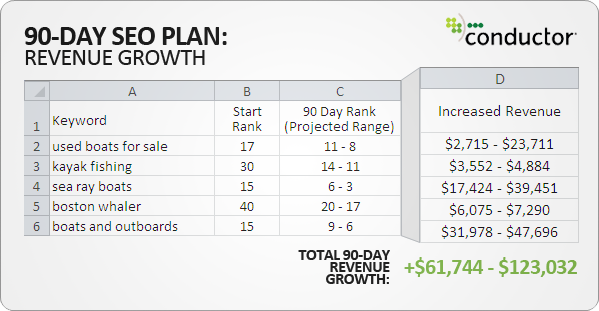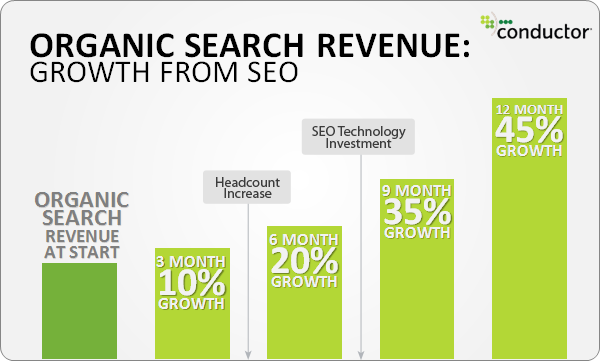Overcoming The Catch 22 Of Investing In Search Without Proof Of Success
Some readers may be surprised to discover that despite the opportunity organic search offers — a recent Shareholic study showed organic search drives nearly half of all traffic, 5 times more than social networks combined — many executive budget holders are still reluctant to make an initial substantial investment in SEO. Other, battle-scarred veterans will […]
Some readers may be surprised to discover that despite the opportunity organic search offers — a recent Shareholic study showed organic search drives nearly half of all traffic, 5 times more than social networks combined — many executive budget holders are still reluctant to make an initial substantial investment in SEO.
Other, battle-scarred veterans will not be nearly as surprised.
Whatever your perspective, the reluctance by senior management to take the leap and make an initial substantial investment in SEO, while theoretically understandable, often leaves the SEO professional lobbying for budget in a chicken and egg, catch-22 situation. “Show me you can move the needle before I am willing to invest,” they are told; but, without the resources, technology, and budget, it can be difficult to demonstrate substantial ROI in a short period of time.
Getting past this hurdle can mean the difference between having a fully-staffed SEO team wielding the latest advanced technology, and being Milton in the basement wielding his SEO stapler; so, it’s critical that you put your best foot forward.
While no plan offers a foolproof guarantee to ensure management buy-in, I’d like to propose a three-part strategy to give you the best chance of success.
Before we dive into the specifics, I want to caution readers that the critical component required for each step along the way is that you engage your inner empath. That is, you need to view things through your budget-holder’s eyes. This means considering what they do and don’t know about the unique nature of SEO and how it differs from other marketing practices, determining the metrics that they care most about and considering the ancillary benefits to SEO beyond capturing traffic that might help to influence their investment.
1. Set Expectations By Defining The Unique Nature Of SEO
Although it may be abundantly clear to you that making headway in natural search is very much a marathon rather than a sprint and that the exact return and rate of return is difficult to define precisely, your marketing executive may be used to a discipline like email marketing where return on investment quickly becomes apparent after an action, or offline channels where the same holds true.
Put another way, it is necessary to start by explaining why the request Show Me Success Before I’ll Invest in SEO is, in fact, a bit of a Catch-22. Time, resources, and the right technology are needed to demonstrate the return the budget-holder is looking for. Do this even if you have messaged this idea to management before — it will help frame the rest of the conversation.
2. Define The Opportunity Using Metrics The Budget Holder Cares About
Now that you’ve set the environment, define the size of the potential search opportunity by calculating website traffic gains from incremental rank improvements for your keywords. There are a number of Excel tools out there that help you calculate potential search opportunity by inputting keywords and search volumes, tweaking rank improvements, and determining traffic increases.
By making use of these tools, you can calculate the size of the organic search opportunity possible in your space.
For example, in the image below, you can see a sample company’s current share of search and the percentage of untapped opportunity available. By fully investing in SEO, this company can theoretically access the 88% of traffic still out of reach and translate this traffic to over $85 million in potential new revenue.
Translating this market opportunity assessment methodology to your individual industry will let you show your budget holder the size of the opportunity in SEO in your industry and will set the table for the next step in the process.
I’m going to take this a step further than many of the articles you may have seen in the making-a-case-to-management-for-SEO investment genre that typically stop at show management the size of the huge opportunity in natural search.
The truth is, (again, engaging our inner empath) from management’s point of view, seeing the size of the potential search opportunity, while well-intentioned, is little more than a promise, and these are often met with I’ll believe it when I see it skepticism (whether explicitly expressed or not).
To take it a step further, after establishing the size of the global opportunity, I’m going to suggest that you actually define what you will accomplish in a 90-day window. Yes, I know that it’s risky to stick your neck out there, especially when at the mercy of the algorithm, but it’s arguably just as risky to talk to management about potential without something to show for it.
To mitigate the risk, while still showing value that would be interesting to the budget holder, first determine the growth you think you can achieve in a 90-day period, again, expressed in metrics the budget-holder cares about, but expressed as a range to mitigate risk (e.g., ‘$10,000-$12,000 sales increase’).
In your projections, it probably makes sense to be conservative and focus on long-tail, high-converting keywords for this initial exercise. Projected rankings can even be below-the-fold or in striking distance positions, as depending on the search volume, moving into non hyper-traffic (1-3) positions can still show significant revenue growth.
3. Execute, Execute, Execute
Once you get sign-off on the 90-day plan, the rubber hits the road. Focus on doing whatever you can to show the growth you projected. You might consider even doing things you might not normally do, such as writing some content yourself, doing some link-building, or optimizing pages for conversion.
At the end of the 90 days, convert your analytics metrics into business metrics and show the budget-holder what you have accomplished. Then, to attain the investment you are looking for in budget, headcount, and technology, create a projection that shows what you could achieve in 6, 9 and 12 months.
The line to walk here is a projection aggressive enough that it remains interesting to your budget-holder but conservative enough that you can achieve or come close to achieving the projections you are putting out there.
Conclusion: Take Bold Steps To Win The Budget You Need
Successfully navigating the chicken-and-egg conundrum (show me you can move the needle before I am willing to invest) can mean the difference in a long-term successful SEO program that generates continued growth in online visits, conversions, and sales, and one that is not funded.
Showing the budget holder the size of the overall opportunity is important, but arguably, many requests for budget are rejected because the budget holder was not sufficiently convinced with a concrete showing of return.
While it carries a bit more risk, committing to a growth range you will achieve in a 90-day period — and then executing on that commitment — will show the budget holder concrete evidence of what can be achieved with an investment in natural search, and hopefully, win you the budget you need.
Contributing authors are invited to create content for Search Engine Land and are chosen for their expertise and contribution to the search community. Our contributors work under the oversight of the editorial staff and contributions are checked for quality and relevance to our readers. The opinions they express are their own.
Related stories
New on Search Engine Land




